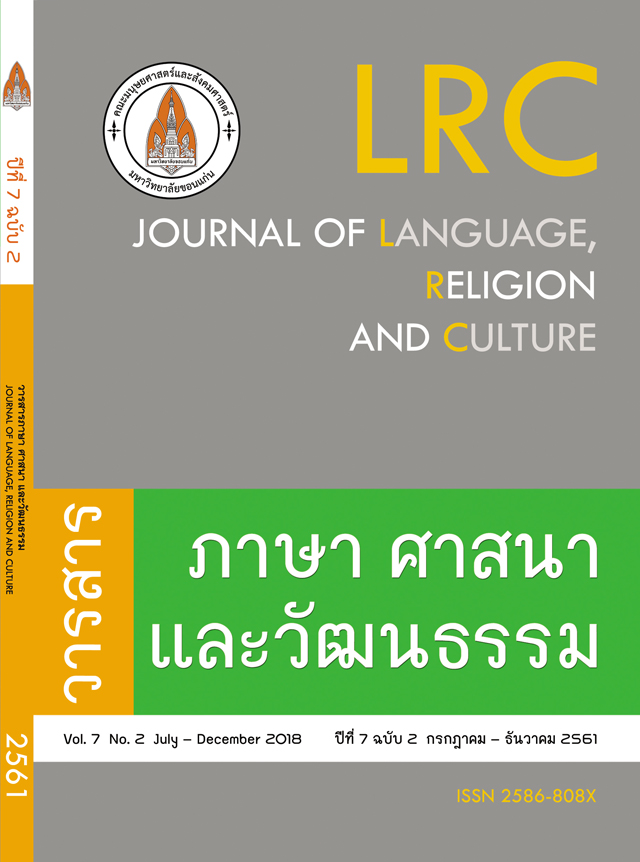แนวคิดเรื่อง “ตถาคตครรภ์” ในคัมภีร์รัตนโคตรวิภาค ; The Concept of Tathãgatagarbha in Ratnagotravibhãga
Keywords:
ตถาคตครรภ์, ธรรมกาย, รัตนโคตรวิภาค, Tathãgatagarbha, Dharmakãya, RatnagotravibhãgaAbstract
วิทยานิพนธ์นี้มีวัตถุประสงค์เพื่อแปลคัมภีร์รัตนโคตรวิภาค มหายาโนตตรตันตรศาสตร์จากต้นฉบับภาษาสันสกฤต เป็นภาษาไทย และเพื่อศึกษาแนวคิดตถาคตครรภ์ที่ปรากฎในคัมภีร์รัตนโคตรวิภาค
ผลการศึกษาพบว่า คัมภีร์รัตนโคตรวิภาค เป็นคัมภีร์ที่รวบรวมคำสอนเกี่ยวกับตถาคตครรภ์ เนื้อหาส่วนใหญ่นำมาจากคัมภีร์พระพุทธศาสนามหายาน ประมาณ 20 คัมภีร์ จึงเป็นคัมภีร์ที่มีเนื้อหาอธิบายเฉพาะเรื่องตถาคตครรภ์มากที่สุด
ตถาคตครรภ์ หมายถึง ธรรมกายที่ยังมีกิเลสอาสวะห่อหุ้ม ซึ่งมีอยู่ในสรรพสัตว์ และสามารถที่จะบรรลุได้ ด้วยการฝึกฝนอบรมจิตให้บริสุทธิ์เป็นประภัสสร ในคัมภีร์นี้ยังมีการใช้คำอื่นๆ แทนคำว่า ตถาคตครรภ์ อีก เช่น สัตตวธาตุ ธรรมธาตุ โคตร ตถตา เป็นต้น สรรพสัตว์ทั้งปวงมีตถาคตครรภ์ เพราะมีธรรมกายแผ่ซ่านอยู่ในตนเอง มีตถตา (ความเป็นจริง) ที่ไม่เปลี่ยนแปลง และมีโคตรอยู่ภายในตน ซึ่งการรู้แจ้งธรรมกายนั้นมี 3 สถานะ กล่าวคือ 1) สถานะที่ธรรมกายยังมีกิเลสห่อหุ้ม เรียกว่า สัตตวธาตุ 2) สถานะที่แม้จะหลุดพ้นจากกิเลสอาสวะทั้งปวงแต่ยังอยู่ในวัฏฏสังสารเพื่ออาศัยความกรุณาช่วยเหลือสรรพสัตว์ เรียกว่า พระโพธิสัตว์ และ 3) สถานะที่หลุดพ้นจากกิเลสอาสวะพร้อมทั้งวาสนาทั้งปวง เรียกว่า พระตถาคต คุณลักษณะของธรรมกาย คือ เที่ยง เป็นสุข เป็นอาตมะ และบริสุทธิ์
Abstract
This study aims at translating the Ratanagotravibhãga Mahãyãnottaratantraśãstra from Sanskrit text into Thai and studying the concept of the tathãgatagarbha as revealed in this scripture.
The study found that the Ratnagotravibhãga is scripture that collected the Buddhist doctrines regarding tathãgatagarbha. The contents were excerpted from sources approximately twenty Mahayana Buddhist scriptures. It is the Buddhist text mostly described and especially concerned with the tathãgatagarbha.
The tathãgatagarbha means the dhammakãya which is encompassed with the defilements. This exists within all living beings, and they will be able to achieve it. They must practice mind to the glittering purity. In this scripture not only the word tathãgatagarbha has been used but there are also other various words which have been used instead such as sattvadhãtu, dharmadhãtu, gotra and tathatã. All living beings have the tathãgatagarbha because within all beings there are the dhammakãya infiltrate in themselves, having the tathatã (the truth) that is unchanging and having the gotra in themselves. The enlightenment of dhammakãya has three conditions namely: 1) A condition that the dhammakãya is encompassed with the defilements, which can be called sattvadhãtu; 2) A partial condition although liberates from all defilements, it still remains in the cycle of existences to help all living beings with compassion, which can be called bodhisattva; 3) A condition liberates from all defilements and all blessedness, which can be called tathãgata. The dhammakãya attributes are exactness, bliss, wholeness (uniformity), and purity.
References
มหายาน. วิทยานิพนธ์ศิลปศาสตรมหาบัณฑิต มหาวิทยาลัยเกษตรศาสตร์.
ฉัตรสุมาลย์ กบิลสิงห์, ผู้แปล. (2532). ศรีมาลาเทวีสีหนาทสูตร. กรุงเทพฯ: จารึก.
. (2544). ศรีมาลาเทวีสีหนาทสูตร. กรุงเทพฯ: เคล็ดไทย จำกัด.
ชัยสิทธิ์ สุวรรณวรางกูล. (2557). ร่องรอยธรรมกายในตถาคตครรภะ. สืบค้นเมื่อ 13 กุมภาพันธ์ 2560,
จาก https://diri-au.org/download/seminar-2014/dr-chaisit.pdf.
. (2559). หลักฐานธรรมกายในคัมภีร์พุทธโบราณ ครั้งที่ 3: ธรรมกายในตถาคตครรภะ.
กรุงเทพฯ: เลี่ยงเชียง.
ดวงพร อาภาศิลป์. (2556). แนวคิดเรื่องตถาคตครรภ์ในพุทธศาสนามหายานอินเดียยุคต้น. วิทยานิพนธ์
ปริญญาศิลปศาสตรมหาบัณฑิต ภาควิชาปรัชญา มหาวิทยาลัยธรรมศาสตร์.
ถาปกรณ์ กำเนิดศิริ. (2552). มโนทัศน์เรื่องพุทธภาวะในฐานะรากฐานทางจริยธรรมในพุทธปรัชญา
มหายาน. วิทยานิพนธ์ปริญญาอักษรศาสตรมหาบัณฑิต ภาควิชาปรัชญา จุฬาลงกรณ์มหาวิทยาลัย.
พันตรี ป. หลงสมบุญ. (2546). พจนานุกรมมคธ-ไทย. กรุงเทพฯ: วัดปากน้ำภาษีเจริญ.
พระธรรมกิตติวงศ์ (ทองดี สุรเตโช). (2550). ศัพท์วิเคราะห์. กรุงเทพฯ: เลี่ยงเชียง.
พระพรหมคุณาภรณ์ (ป.อ.ปยุตฺโต). (2551). พจนานุกรมพุทธศาสน์ ฉบับประมวลศัพท์. พิมพ์ครั้งที่ 11.
กรุงเทพฯ: เอส อาร์ พริ้นติ้ง แมส โปรดักส์ จำกัด.
พระมหาพุทธรักษ์ ปราบนอก. (2547). การศึกษาวิเคราะห์คัมภีร์มหายานสูตราลังการ. วิทยานิพนธ์
ปริญญาศิลปศาสตรดุษฎีบัณฑิต ภาควิชาภาษาตะวันออก มหาวิทยาลัยศิลปากร.
พระมหายุทธนา นรเชฏฺโฐ (ศิริวรรณ). (2556). พัฒนาการแนวคิดตถาคตครรภ์ในพระพุทธศาสนามหายาน
(ฉบับปรับปรุง). กรุงเทพฯ: โรงพิมพ์มหาจุฬาลงกรณราชวิทยาลัย.
พระมหาสมบูรณ์ วุฑฺฒิกโร (พรรณนา). (2550). จิตตมาตรของนิกายโยคาจาร : การศึกษาเชิงวิเคราะห์บน
ฐานแนวคิดเรื่องจิตในพระพุทธศาสนายุคต้น. วิทยานิพนธ์ปริญญาพุทธศาสตรดุษฎีบัณฑิต
สาขาวิชาพระพุทธศาสนา มหาวิทยาลัยมหาจุฬาลงกรณราชวิทยาลัย.
ภัทรพร สิริกาญจน และคนอื่นๆ. (2546). ความรู้พื้นฐานทางศาสนา. พิมพ์ครั้งที่ 4. กรุงเทพฯ:
มหาวิทยาลัยธรรมศาสตร์.
ล. เสถียรสุต. (2519). ประวัติแนวคิดมหายาน. กรุงเทพฯ: โรงพิมพ์รุ่งนคร.
ส. ศิวรักษ์. (2542). ความเข้าใจในเรื่องมหายาน. กรุงเทพฯ: ส่องศยาม จำกัด.
สุมาลี มหณรงค์ชัย. (2541). อาลยวิชญาณในพุทธปรัชญานิกายโยคาจาร. วิทยานิพนธ์ปริญญาอักษร
ศาสตรมหาบัณฑิต ภาควิชาปรัชญา จุฬาลงกรณ์มหาวิทยาลัย.
. (2550). พุทธศาสนามหายาน. กรุงเทพฯ: อมรินทร์พรินติ้ง.
เสถียร โพธินันทะ. (2516). ชุมนุมพระสูตรมหายาน. กรุงเทพฯ: บรรณาคาร.
. (2520). บ่อเกิดลัทธิมหายาน. กรุงเทพฯ: โรงพิมพ์มหามกุฏราชวิทยาลัย.
. (2522). ปรัชญามหายาน. กรุงเทพฯ: บรรณาคาร.
Brown, B.E. (1991). The Buddha Nature. Delhi: Motilal Banarsidass Publishers Private Ltd.
Harvey, P. (1990). An introduction to Buddhism. London: Cambridge University Press.
Johnson, E.H. (1950). The Ratnagotravibhãga Mahayanottaratantrasastra. Patna: The
Bihar Research Society.
Monier-Williams, W. (1899). Sanskrit-English Dictionary. Delhi: Motilal Banarsidass Publishers
Private Limited.
Obermiller, E. (1931). Uttaratantra or Ratnagotravibhãga. Heidelberg: Acta orientalia.
. (1931). The Sublime Science of the Great Vehicle to Salvation, Being a Manual
of Buddhist Monism. Acta Orientalia. Vol. IX p. 104.
Suzaki, D.T. (1968). The Lankãvatãra Sũtra. London: Routledge & Kegan Paul Ltd.
Takasaki, J. (1964). A Study on the Ratnagotravibhãga (Uttaratantra) Being a Treatise
on the Tathãgatagarbha Theory of Mahayana Buddhism. Roma: Istituto Italiano
Per II Medio Ed Estremo Oriente.
Wayman A. & Wayman H. (1974). The Lion’s Roar of Queen Srimala. New York &
London: Columbia University Press.
Williams, P. (2000). Buddhist Thought. London: Routledge.
Zimmerman, M. (1998). Tathagatagarbhasutra: Its Basic Structure and Relation to the
Lotus Sutra. Annual Report of the International Research Institute for Advanced
Buddhology at Soka University for the Academic Year 1998. pp. 143-168.







